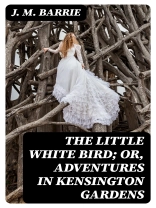In ‘The Little White Bird; Or, Adventures in Kensington Gardens, ‘ J. M. Barrie masterfully intertwines fantasy and reality, crafting a tale rich in whimsy and charm. Set against the backdrop of Kensington Gardens, the narrative unfolds through a series of enchanting adventures featuring a young boy and the magical creatures he encounters, including the iconic Peter Pan. Barrie’s lyrical prose and imaginative storytelling reflect the Edwardian literary context, illustrating the era’s fascination with childhood innocence and the interplay between the mundane and the extraordinary. J. M. Barrie, best known for creating the beloved character of Peter Pan, drew inspiration from his own experiences and relationships, particularly his bond with the Llewelyn Davies boys. This connection to youth permeates Barrie’s work, allowing him to capture the delicate balance between carefree childhood and the encroaching responsibilities of adulthood. His unique ability to evoke nostalgia for lost childhood has cemented his place in the literary canon. I wholeheartedly recommend ‘The Little White Bird’ to readers of all ages who seek a profound exploration of childhood, imagination, and the significance of play. Barrie’s storytelling transcends time, inviting readers to linger in the magic of Kensington Gardens and reflect on the beauty of youthful wonder.
关于作者
Sir James Matthew Barrie, known as J. M. Barrie (1860-1937), was a distinguished Scottish novelist and playwright, celebrated for his enchanting works that epitomized the Victorian and Edwardian eras. Barrie’s most fabled contribution to literature is his creation of Peter Pan, the boy who wouldn’t grow up, a character that first appeared in ‘The Little White Bird; Or, Adventures in Kensington Gardens’ (1902). The whimsical tale, set in London’s iconic Kensington Gardens, served as a backdrop for introducing Peter Pan to the world, a character that would later anchor Barrie’s most famous play, ‘Peter Pan; or, the Boy Who Wouldn’t Grow Up’ (1904). Barrie’s literary style was characterized by a blend of sentimentality, fantasy, and social comedy, which endeared him to both children and adult audiences. His empathy for children, combined with his skillful use of both humor and pathos, marked him as a storyteller with a unique ability to capture the innocence and adventure of childhood. Barrie’s works often explored themes of escapism and the juxtaposition of reality and fantasy. In addition to his iconic contribution of Peter Pan, his oeuvre includes a number of novels and plays that enjoyed considerable popularity in their time. His literary efforts earned him the title of baronet in 1913 and a legacy as one of Scotland’s most beloved authors.












